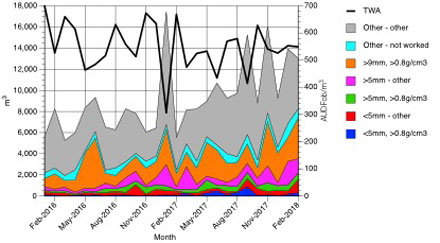
Imports of MDF leaped 41% over the year-ended February, totalling more than 131,000m3. The rise in imports of MDF, along with higher imports of all other panel products raises important strategic questions for the domestic industry, according to trade and market consultants IndustryEdge. Source: IndustryEdge for Timberbiz
Analysis of the latest import data shows, according to IndustryEdge, that not only have imports risen, but that average prices were very stable over the last year.
“We have seen over the last year that imports of MDF have risen by 41%, which is substantial on any basis,” Tim Woods, managing director of IndustryEdge said.
“But at the same time, we have seen the average price of imports increase less than 1% over that period. That tells us that price has not been the motivating factor in driving imports higher.”
The average price of imported MDF, measured on a ‘free-on-board’ basis, which is before any shipping costs are taken into account, was AUDFob523.67/m3 for the year-ended February 2018.
Other panel products have also experienced large import increases over the last year. Plywood imports totalled 500,000m3 over the same period, a rise of more than 27%, while Particleboard imports were up 37% with imports totalling almost 120,000 m3.
“Plywood and particleboard import prices have fallen over the last year,” Mr Woods said. “That looks to have been a driver for their importation, but we don’t think that explains all of the rise in imports. When we look at the combined volume for panel products – and we think it is reasonable to do that in this case – we see almost 200,000 m3 additional supply than a year ago. That is significant.”
With the relevant housing approvals and commencements growing modestly over the last year – house and townhouse approvals rose over the year, while apartments and flats declined dramatically – demand for these products does not appear to have increased significantly.
“Markets have their ups and downs, and that includes imports obviously. But we simply cannot see the additional consumption this volume of imports would be supplying,” Mr Woods said.
IndustryEdge would not be drawn on whether the rising imports was impacting the domestic industry. The spread of the rising imports across multiple products and grades may mean the full effect has been spread across producers, with none being especially exposed, at least at this stage.
IndustryEdge advises they anticipate addressing the likely drivers for the rising imports in the May edition of the monthly Wood Market Edge.
Wood Market Edge is available for subscription, and is also provided on a complimentary basis to subscribers to the monthly wood products trade data series, which includes Woodchip Export, Log Export and Sawnwood Import and Export data.
Go to www.industryedge.com.au





